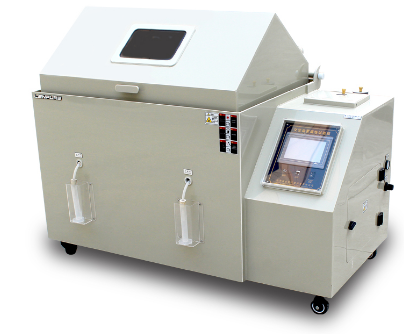Climatic chambers for standard ISO 7253-2001 Paints and varnishes--determination of resistance to neutral salt spray (fog)
This is International standard is one of a series of standards dealing with the sampling and testing of paints, varnishes and related products. It describes a method for determining the resistance of coatings to neutral salt spray (fog) in accordance with the requirements of coatings or product specifications. This standard needs a climatic chamber--salt spray test chamber.
A coated test panel is exposed to neutral salt spray (fog) and the effects of exposure are evaluated by criteria agreed in advance between the interested parties, these criteria usually being of a subjective nature.
The test solution shall be prepared by dissolving sodium chloride in water of at least grade 3 purity as defined in ISO 3696 to produce a concentration of (50±5)g/l. The sodium chloride shall be white, of minimum assay 99.6%(m/m), and substantially free from copper and nickel; it shall contain not more than 0.1%(m/m) of sodium iodide. If the PH of the solution is outside the range 6.0 to 7.0, the presence of undesirable impurities in the salt or the water or both shall be investigated.
The PH of the test solution shall be adjusted so that the PH of sprayed solution collected within the test cabinet shall be between 6.5 to 7.2. Any necessary adjustment to the PH shall be made by additions of solution of either hydrochloric acid or sodium bicarbonate of analytical grade.
The test solution shall be filtered before it is placed in the reservoir of the apparatus, in order to remove any solid matter which might block the nozzles of the spraying device.
Ordinary laboratory apparatus and glassware, together with the following:
6.1 A spray cabinet, made of, or lined with, material resistant to corrosion by the spray and with a roof which prevents condensed moisture dripping on to the test panels. The cabinet shall have a capacity of not less than 0.4m³since, with smaller volumes, difficulties are experienced in ensuring even distribution of spray.

The size and shape of the cabinet shall be such that the quantity of solution collected in the spray-collecting devices is within the limits stated in 10.2.
Cabinets with a volume greater than 2m³ will be difficult to operate unless careful consideration is given to their design and construction.
6.2 Adjustable heater, adequate to maintain the cabinet and its contents at the specified temperature. The temperature shall be controlled by a thermostat element placed within the cabinet at least 100mm from the walls. A thermometer, capable of being read from the outside, shall be placed wholly within the cabinet at least 100mm from the walls, roof or floor.
6.3 Spraying device, comprising a supply of clean compressed air of constant pressure and humidity, a reservoir containing the solution the solution to be sprayed and one or more spray nozzles made of material resistant to the solution.
The compressed air supply to each spray nozzle shall be passed through a filter to remove all traces of oil or solid matter and shall be at a pressure of 70kPa to 170kPa. In order to prevent evaporation of the spray droplets, the air shall be humidified before entering each nozzle by passage through a saturation column containing water of at least grade 3purity as defined in ISO 3696 at a temperature several degrees Celsius higher than that of the cabinet.
The actual temperature of the water will depend on the pressure used and on the type of spray nozzle, and shall be adjusted so that the rate of collection of spray in the cabinet and the sodium chloride concentration of the spray collected are kept within the specified limits.
The reservoir containing the test solutions shall be made of material resistant to the solution and shall be provided with a means of delivering a constant volume of solution to the spray nozzles at all times.
The spray nozzles shall be made of insert material, for example glass or plastic.
The cabinet shall be vented to ensure that there is no build up of pressure within the cabinet and in such a way that the environment outside the cabinet does not influence that inside the cabinet.
6.4 Spray-collecting devices, of chemically insert material. The collecting devices shall be placed in the zone of the cabinet where the test panels are placed, at least one close to a spray nozzle and one remote from a spray nozzle. They shall be placed so that only spray is collected, and not liquid dripping from test panels or parts of the holders or cabinet. The number of collecting devices shall be at least twice the number of spray nozzles.
6.5 Test panel holders, capable of supporting the test panels at an angle of between 15° and 25° to the vertical, normally racks made of insert non-metallic material such as glass, plastic or suitably coated wood. Exceptionally, if it is necessary to suspend the test panels, the material used shall be synthetic fibre, cotton thread or another insert insulating material, but on no account metallic material. The test panels may be located at different levels in the cabinet but they shall be positioned so that the solution cannot drip from panels or holders at one level on to other panels below.
If the equipment has been used for a spray test, or for any other purpose, with a solution differing from that specified for this test, it shall be thoroughly cleaned before use.
For more details, please feel free to contact sales@lenpure.com
Please visit www.lenpure.com











